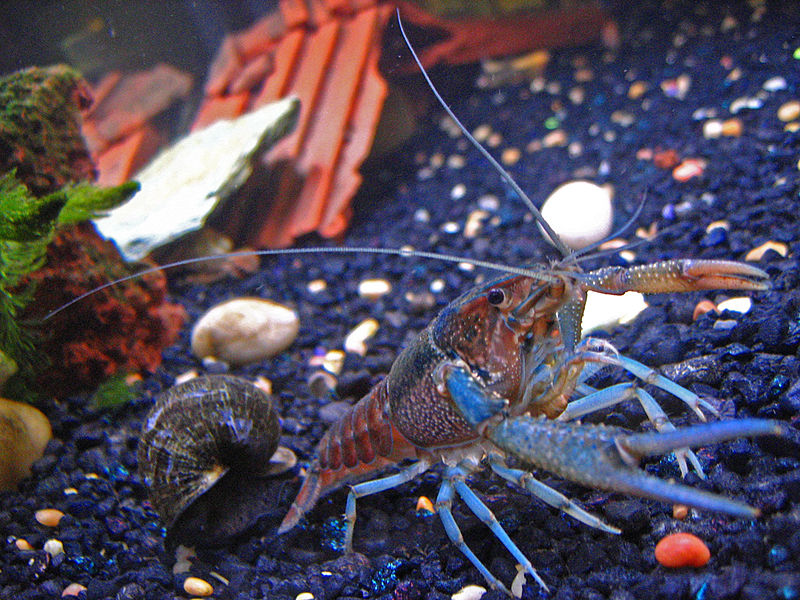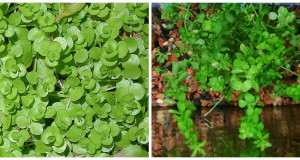 Hello, Frank Indiviglio here. I’m glad to see that crayfishes are beginning to get more attention from aquarists. Many can be bred in the aquarium, and their colors, ranging from apricot to blue and deep red, rival those of any marine invertebrate. The USA, home to over 80% of the 600+ known species, is a center of their diversity (84 species occur in Alabama alone). The year 2011 opened with a bang for Crayfish enthusiasts – a unique new species, twice the size of those nearby, was discovered Tennessee. “Tennessee Giant Crayfish” would seem a suitable common name, but for now the unique crustacean is known only as Barbicambarus simmonsi.
Hello, Frank Indiviglio here. I’m glad to see that crayfishes are beginning to get more attention from aquarists. Many can be bred in the aquarium, and their colors, ranging from apricot to blue and deep red, rival those of any marine invertebrate. The USA, home to over 80% of the 600+ known species, is a center of their diversity (84 species occur in Alabama alone). The year 2011 opened with a bang for Crayfish enthusiasts – a unique new species, twice the size of those nearby, was discovered Tennessee. “Tennessee Giant Crayfish” would seem a suitable common name, but for now the unique crustacean is known only as Barbicambarus simmonsi.
The crayfish first came to light in the form of a photo by someone who thought it might be unique. Biologists from the Universities of Illinois and Eastern Kentucky, following this lead, found one under a huge stone in the deepest part of its native stream. Several small populations are now known from Alabama as well. Its only close relative, Tennessee’s Barbicambarus cornuta, grows as large as a small lobster.
New Species are Lurking Everywhere
The discovery of this crayfish should, I believe, serve as an inspiration for anyone who believes that only far-off, “exotic” locales hold undiscovered creatures. This 5-inch-long, distinctly-colored invertebrate was found in a stream that has been intensely sampled and studied by biologists for over 50 years!
While tiny, “plain” insects are sometimes not recognized as being new until subjected to genetic studies, the Tennessee Giant Crayfish is unmistakable – in fact, the genus to which it belongs contains only 1 other member. It is twice the size of the other crayfishes dwelling in its habitat, and its antennae bear unusual hair-like bristles, or setae, that assist in sensing food and danger. As its discoverers put it, any aquatic biologist would have recognized the crayfish “…as something really, really, different, and would have saved it.” It simply has not been seen before!
Keeping Crayfishes
Crayfishes make wonderful aquarium subjects, with most being quite willing to display all their behaviors in captivity. In fact, some are ideal classroom animals – please check out our Crayfish in the Classroom Kit to learn more about using them as an educational tool.
Many crayfishes that show up in the pet trade have interesting habits – the tiny Red-Tipped Crayfish, Orconectes erichsonianus, is an industrious “builder” that continually moves gravel about, while the huge Red Swamp Crayfish, Procambarus clarkii, exhibits complex maternal care (please see article below). I’ve been keeping Asian Zebra Crayfishes, Cherax misolicus, for the past few years, and find them to be among the most spectacular invertebrates I’ve run across.
I’ll cover crayfish care in future articles. Until then, please write in with your questions and comments…and new discoveries! Thanks, Frank Indiviglio.
Further Reading
Photos of the new Giant Crayfish
 That Fish Blog – Aquarium Advice and Information
That Fish Blog – Aquarium Advice and Information



Hello Mr. Indiviglio,
Have you ever kept the Australian red claw crayfish, Cherax quadricarinatus? Ifso can you give me some info on their care? Specifically their diet. I recently got a 4-5 inch SVL male from a LFS and he seems to be feeding well on a pellet mix/shrimp pellets, fish and insects but I read that they should be given a mostly plant based diet so I’m about to try giving him some vegetables. I was quite surprised to see numerous chew marks on the plastic plants the day after I got him. I heard these guys can be blueish in color but mine only has some on his claws and is mostly reddish brown. Also, what’s the biggest you’ve seen these get? I keep seeing 12″ everywhere and if he does get that big then I can’t wait, although that may take a while. Thanks!
Cheers, Alex
Hi Alex,
I’ve not seen them here in the US (are you in the UK?)but have spoken with some folks elsewhere re their care. No need to worry about amount vegetation etc..they are generalists, do fine on shrimp or catfish pellets as a base, fish, insects, greens for variety; commercial farms use grain etc as it’s less expensive. They have been commercially bred for some time now, so care is well-researched; useful info here.. Best info I have on size is 10″ for males and to 500-600 grams, which is quite a hefty crayfish; larger possible I’ll bet. Said to get on well in groups, which is odd for crayfish…let me know how you do, very interesting beasts. Color varies quite a bit; please keep me posted, best Frank
I am actually just outside of D.C. My local fish store has them quite frequently so I got him to help eat any leftover food.
Also, I recently got a 5 spot jewel cichlid and at first it was quite timid but now it has beaten up all the other cichlids to a point where I had to move them. Do you have any suggestions for suitable tankmates?
Hi Alex,
Thanks very much!…I didn’t realize they were available here, I’m going to look around.
All 3 species sold under that name are very difficult to mix and to pair-up. With similar cichlids, it sometimes helps to try large cichlids that have a very different body shape, or various Syndontis catfishes; but always a gamble, and as you’ve seen aggression is hard to predict, not necessarily related to breeding.
Best, Frank